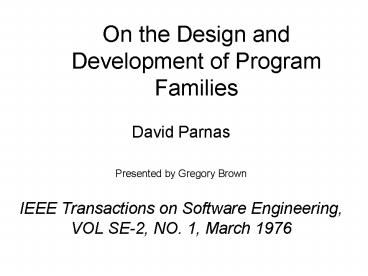On the Design and Development of Program Families PowerPoint PPT Presentation
Title: On the Design and Development of Program Families
1
On the Design and Development of Program Families
- David Parnas
- Presented by Gregory Brown
- IEEE Transactions on Software Engineering, VOL
SE-2, NO. 1, March 1976
2
Ouline
- Problem and Motivation
- Overview of Contribution
- Stepwise Refinement
- Module Specification
- Example Application
- Stepwise Refinement
- Module Specification
- Impact
- Open Questions
3
Problem and Motivation
- Problem
- Investigated production of program families
- Classical Method sequential completion
- Each member was a full working program
- Each one built from an ancestor
- Each inherits the design decisions of ancestors
- Motivation
- Make good, common design decisions up front
- Parallel development of family members
4
Overview of Contribution
- Stepwise Refinement
- Each member is a functioning program
- Successive steps add funcitonality
- Each step represents design decision(s)
- No unnecessary functionality
- No performance degradation
- Revert back to previous step
5
Overview of Contribution
- Module Specification
- Intermediate steps not programs
- Steps are specifications of collections of
functionality - Modules made to hide design decisions
- Early work designed to postpone decisions
- Make a wide program family possible
6
Overview of Contribution
- Module method avoids disadvantages of stepwise
refinement - Stepwise refinement does make design decisions -
rollback can lose this - The two are complementary
- Stepwise refinement lower complexity
- Module method requires more work
7
Example application
- Stepwise refinement
- Dijkstras prime problem
- Step 1
- bestyet nullwhile not all.spaces considered
do begin find next item from list of free
spaces bestyet bestof(bestyet,candidate) end
if bestyet null then erroraction allocate(be
st yet)remove(best yet)
8
Example application
- Stepwise refinement
- Step 2
- bestyet 0candidate 0while candidate ! N
do begin candidate candidate1 bestyet
bestof(bestyet,candidate) endif bestyet 0
then erroractionallocate(best yet)remove(best
yet)
9
Example application
- Module Specification
- Dijkstras prime problem
- Split into information-hiding modules
- Modules
- Free space list
- Allocation
- Selection criterium
10
Impact
- Stepwise refinement is often used
- Add functionality to existing software
- Using modules and patterns
- General strategy to developing systems
- Revision control systems
- Module specification part of OO design
- Encapsulation to hide implementation
- Commonly taught and used practice
- Module specification allowed for development of
patterns
11
Impact
- Stepwise refinement and module specification
complementary - Can create software in stages, but using modules
- Complementary approaches
- Use strategy pattern among others to ease work
12
Open Questions
- How could the two best be combined to enhance
software development? - When is it a good idea to not use stepwise
refinement or module specification? - Does the classic approach Parnas described not
have a place at all?

